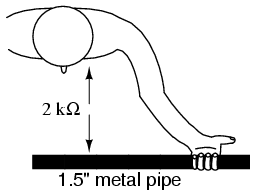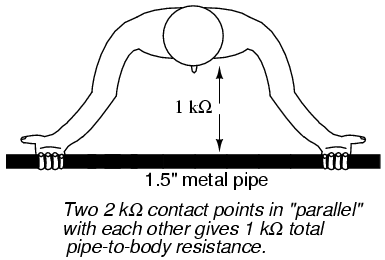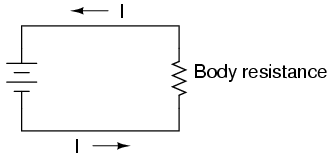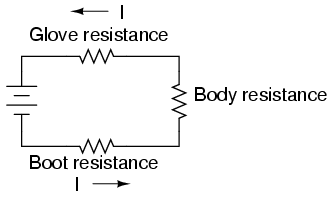Ohm's Law (again!)
A common phrase heard in reference to
electrical safety goes something like this: "It's not
voltage that kills, it's current!" While there is an
element of truth to this, there's more to understand about
shock hazard than this simple adage. If voltage presented no
danger, no one would ever print and display signs saying:
DANGER -- HIGH VOLTAGE!
The principle that "current kills" is
essentially correct. It is electric current that burns
tissue, freezes muscles, and fibrillates hearts. However,
electric current doesn't just occur on its own: there must
be voltage available to motivate electrons to flow through a
victim. A person's body also presents resistance to current,
which must be taken into account.
Taking Ohm's Law for voltage, current, and
resistance, and expressing it in terms of current for a
given voltage and resistance, we have this equation:

The amount of current through a body is
equal to the amount of voltage applied between two points on
that body, divided by the electrical resistance offered by
the body between those two points. Obviously, the more
voltage available to cause electrons to flow, the easier
they will flow through any given amount of resistance.
Hence, the danger of high voltage: high voltage means
potential for large amounts of current through your body,
which will injure or kill you. Conversely, the more
resistance a body offers to current, the slower electrons
will flow for any given amount of voltage. Just how much
voltage is dangerous depends on how much total resistance is
in the circuit to oppose the flow of electrons.
Body resistance is not a fixed quantity. It
varies from person to person and from time to time. There's
even a body fat measurement technique based on a measurement
of electrical resistance between a person's toes and
fingers. Differing percentages of body fat give provide
different resistances: just one variable affecting
electrical resistance in the human body. In order for the
technique to work accurately, the person must regulate their
fluid intake for several hours prior to the test, indicating
that body hydration another factor impacting the body's
electrical resistance.
Body resistance also varies depending on how
contact is made with the skin: is it from hand-to-hand,
hand-to-foot, foot-to-foot, hand-to-elbow, etc.? Sweat,
being rich in salts and minerals, is an excellent conductor
of electricity for being a liquid. So is blood, with its
similarly high content of conductive chemicals. Thus,
contact with a wire made by a sweaty hand or open wound will
offer much less resistance to current than contact made by
clean, dry skin.
Measuring electrical resistance with a
sensitive meter, I measure approximately 1 million ohms of
resistance (1 MΩ) between my two hands, holding on to the
meter's metal probes between my fingers. The meter indicates
less resistance when I squeeze the probes tightly and more
resistance when I hold them loosely. Sitting here at my
computer, typing these words, my hands are clean and dry. If
I were working in some hot, dirty, industrial environment,
the resistance between my hands would likely be much less,
presenting less opposition to deadly current, and a greater
threat of electrical shock.
But how much current is harmful? The answer
to that question also depends on several factors. Individual
body chemistry has a significant impact on how electric
current affects an individual. Some people are highly
sensitive to current, experiencing involuntary muscle
contraction with shocks from static electricity. Others can
draw large sparks from discharging static electricity and
hardly feel it, much less experience a muscle spasm. Despite
these differences, approximate guidelines have been
developed through tests which indicate very little current
being necessary to manifest harmful effects (again, see end
of chapter for information on the source of this data). All
current figures given in milliamps (a milliamp is equal to
1/1000 of an amp):
BODILY EFFECT DIRECT CURRENT (DC) 60 Hz AC 10 kHz AC
---------------------------------------------------------------
Slight sensation Men = 1.0 mA 0.4 mA 7 mA
felt at hand(s) Women = 0.6 mA 0.3 mA 5 mA
---------------------------------------------------------------
Threshold of Men = 5.2 mA 1.1 mA 12 mA
perception Women = 3.5 mA 0.7 mA 8 mA
---------------------------------------------------------------
Painful, but Men = 62 mA 9 mA 55 mA
voluntary muscle Women = 41 mA 6 mA 37 mA
control maintained
---------------------------------------------------------------
Painful, unable Men = 76 mA 16 mA 75 mA
to let go of wires Women = 51 mA 10.5 mA 50 mA
---------------------------------------------------------------
Severe pain, Men = 90 mA 23 mA 94 mA
difficulty Women = 60 mA 15 mA 63 mA
breathing
---------------------------------------------------------------
Possible heart Men = 500 mA 100 mA
fibrillation Women = 500 mA 100 mA
after 3 seconds
---------------------------------------------------------------
"Hz" stands for the unit of Hertz,
the measure of how rapidly alternating current alternates, a
measure otherwise known as frequency. So, the column
of figures labeled "60 Hz AC" refers to current that
alternates at a frequency of 60 cycles (1 cycle = period of
time where electrons flow one direction, then the other
direction) per second. The last column, labeled "10 kHz AC,"
refers to alternating current that completes ten thousand
(10,000) back-and-forth cycles each and every second.
Keep in mind that these figures are only
approximate, as individuals with different body chemistry
may react differently. It has been suggested that an
across-the-chest current of only 17 milliamps AC is enough
to induce fibrillation in a human subject under certain
conditions. Most of our data regarding induced fibrillation
comes from animal testing. Obviously, it is not practical to
perform tests of induced ventricular fibrillation on human
subjects, so the available data is sketchy. Oh, and in case
you're wondering, I have no idea why women tend to be more
susceptible to electric currents than men!
Suppose I were to place my two hands across
the terminals of an AC voltage source at 60 Hz (60 cycles,
or alternations back-and-forth, per second). How much
voltage would be necessary in this clean, dry state of skin
condition to produce a current of 20 milliamps (enough to
cause me to become unable to let go of the voltage source)?
We can use Ohm's Law (E=IR) to determine this:
E = IR
E = (20 mA)(1 MΩ)
E = 20,000 volts, or 20 kV
Bear in mind that this is a "best case"
scenario (clean, dry skin) from the standpoint of electrical
safety, and that this figure for voltage represents the
amount necessary to induce tetanus. Far less would be
required to cause a painful shock! Also keep in mind that
the physiological effects of any particular amount of
current can vary significantly from person to person, and
that these calculations are rough estimates only.
With water sprinkled on my fingers to
simulate sweat, I was able to measure a hand-to-hand
resistance of only 17,000 ohms (17 kΩ). Bear in mind this is
only with one finger of each hand contacting a thin metal
wire. Recalculating the voltage required to cause a current
of 20 milliamps, we obtain this figure:
E = IR
E = (20 mA)(17 kΩ)
E = 340 volts
In this realistic condition, it would only
take 340 volts of potential from one of my hands to the
other to cause 20 milliamps of current. However, it is still
possible to receive a deadly shock from less voltage than
this. Provided a much lower body resistance figure augmented
by contact with a ring (a band of gold wrapped around the
circumference of one's finger makes an excellent
contact point for electrical shock) or full contact with a
large metal object such as a pipe or metal handle of a tool,
the body resistance figure could drop as low as 1,000 ohms
(1 kΩ), allowing an even lower voltage to present a
potential hazard:
E = IR
E = (20 mA)(1 kΩ)
E = 20 volts
Notice that in this condition, 20 volts is
enough to produce a current of 20 milliamps through a
person: enough to induce tetanus. Remember, it has been
suggested a current of only 17 milliamps may induce
ventricular (heart) fibrillation. With a hand-to-hand
resistance of 1000 Ω, it would only take 17 volts to create
this dangerous condition:
E = IR
E = (17 mA)(1 kΩ)
E = 17 volts
Seventeen volts is not very much as far as
electrical systems are concerned. Granted, this is a
"worst-case" scenario with 60 Hz AC voltage and excellent
bodily conductivity, but it does stand to show how little
voltage may present a serious threat under certain
conditions.
The conditions necessary to produce 1,000 Ω
of body resistance don't have to be as extreme as what was
presented, either (sweaty skin with contact made on a gold
ring). Body resistance may decrease with the application of
voltage (especially if tetanus causes the victim to maintain
a tighter grip on a conductor) so that with constant voltage
a shock may increase in severity after initial contact. What
begins as a mild shock -- just enough to "freeze" a victim
so they can't let go -- may escalate into something severe
enough to kill them as their body resistance decreases and
current correspondingly increases.
Research has provided an approximate set of
figures for electrical resistance of human contact points
under different conditions (see end of chapter for
information on the source of this data):
-
Wire touched by finger: 40,000 Ω to
1,000,000 Ω dry, 4,000 Ω to 15,000 Ω wet.
-
Wire held by hand: 15,000 Ω to 50,000 Ω
dry, 3,000 Ω to 5,000 Ω wet.
-
Metal pliers held by hand: 5,000 Ω to
10,000 Ω dry, 1,000 Ω to 3,000 Ω wet.
-
Contact with palm of hand: 3,000 Ω to
8,000 Ω dry, 1,000 Ω to 2,000 Ω wet.
-
1.5 inch metal pipe grasped by one hand:
1,000 Ω to 3,000 Ω dry, 500 Ω to 1,500 Ω wet.
-
1.5 inch metal pipe grasped by two hands:
500 Ω to 1,500 kΩ dry, 250 Ω to 750 Ω wet.
-
Hand immersed in conductive liquid: 200 Ω
to 500 Ω.
-
Foot immersed in conductive liquid: 100 Ω
to 300 Ω.
Note the resistance values of the two
conditions involving a 1.5 inch metal pipe. The resistance
measured with two hands grasping the pipe is exactly
one-half the resistance of one hand grasping the pipe.

With two hands, the bodily contact area is
twice as great as with one hand. This is an important lesson
to learn: electrical resistance between any contacting
objects diminishes with increased contact area, all other
factors being equal. With two hands holding the pipe,
electrons have two, parallel routes through which to
flow from the pipe to the body (or visa-versa).

As we will see in a later chapter,
parallel circuit pathways always result in less overall
resistance than any single pathway considered alone.
In industry, 30 volts is generally
considered to be a conservative threshold value for
dangerous voltage. The cautious person should regard any
voltage above 30 volts as threatening, not relying on normal
body resistance for protection against shock. That being
said, it is still an excellent idea to keep one's hands
clean and dry, and remove all metal jewelry when working
around electricity. Even around lower voltages, metal
jewelry can present a hazard by conducting enough current to
burn the skin if brought into contact between two points in
a circuit. Metal rings, especially, have been the cause of
more than a few burnt fingers by bridging between points in
a low-voltage, high-current circuit.
Also, voltages lower than 30 can be
dangerous if they are enough to induce an unpleasant
sensation, which may cause you to jerk and accidently come
into contact across a higher voltage or some other hazard. I
recall once working on a automobile on a hot summer day. I
was wearing shorts, my bare leg contacting the chrome bumper
of the vehicle as I tightened battery connections. When I
touched my metal wrench to the positive (ungrounded) side of
the 12 volt battery, I could feel a tingling sensation at
the point where my leg was touching the bumper. The
combination of firm contact with metal and my sweaty skin
made it possible to feel a shock with only 12 volts of
electrical potential.
Thankfully, nothing bad happened, but had
the engine been running and the shock felt at my hand
instead of my leg, I might have reflexively jerked my arm
into the path of the rotating fan, or dropped the metal
wrench across the battery terminals (producing large
amounts of current through the wrench with lots of
accompanying sparks). This illustrates another important
lesson regarding electrical safety; that electric current
itself may be an indirect cause of injury by causing you to
jump or spasm parts of your body into harm's way.
The path current takes through the human
body makes a difference as to how harmful it is. Current
will affect whatever muscles are in its path, and since the
heart and lung (diaphragm) muscles are probably the most
critical to one's survival, shock paths traversing the chest
are the most dangerous. This makes the hand-to-hand shock
current path a very likely mode of injury and fatality.
To guard against such an occurrence, it is
advisable to only use on hand to work on live circuits of
hazardous voltage, keeping the other hand tucked into a
pocket so as to not accidently touch anything. Of course, it
is always safer to work on a circuit when it is
unpowered, but this is not always practical or possible. For
one-handed work, the right hand is generally preferred over
the left for two reasons: most people are right-handed (thus
granting additional coordination when working), and the
heart is usually situated to the left of center in the chest
cavity.
For those who are left-handed, this advice
may not be the best. If such a person is sufficiently
uncoordinated with their right hand, they may be placing
themselves in greater danger by using the hand they're least
comfortable with, even if shock current through that hand
might present more of a hazard to their heart. The relative
hazard between shock through one hand or the other is
probably less than the hazard of working with less than
optimal coordination, so the choice of which hand to work
with is best left to the individual.
The best protection against shock from a
live circuit is resistance, and resistance can be added to
the body through the use of insulated tools, gloves, boots,
and other gear. Current in a circuit is a function of
available voltage divided by the total resistance in
the path of the flow. As we will investigate in greater
detail later in this book, resistances have an additive
effect when they're stacked up so that there's only one path
for electrons to flow:


Now we'll see an equivalent circuit for a
person wearing insulated gloves and boots:


Because electric current must pass through
the boot and the body and the glove to
complete its circuit back to the battery, the combined total
(sum) of these resistances opposes the flow of
electrons to a greater degree than any of the resistances
considered individually.
Safety is one of the reasons electrical
wires are usually covered with plastic or rubber insulation:
to vastly increase the amount of resistance between the
conductor and whoever or whatever might contact it.
Unfortunately, it would be prohibitively expensive to
enclose power line conductors in sufficient insulation to
provide safety in case of accidental contact, so safety is
maintained by keeping those lines far enough out of reach so
that no one can accidently touch them.
-
REVIEW:
-
Harm to the body is a function of the
amount of shock current. Higher voltage allows for the
production of higher, more dangerous currents. Resistance
opposes current, making high resistance a good protective
measure against shock.
-
Any voltage above 30 is generally
considered to be capable of delivering dangerous shock
currents.
-
Metal jewelry is definitely bad to wear
when working around electric circuits. Rings, watchbands,
necklaces, bracelets, and other such adornments provide
excellent electrical contact with your body, and can
conduct current themselves enough to produce skin burns,
even with low voltages.
-
Low voltages can still be dangerous even
if they're too low to directly cause shock injury. They
may be enough to startle the victim, causing them to jerk
back and contact something more dangerous in the near
vicinity.
-
When necessary to work on a "live"
circuit, it is best to perform the work with one hand so
as to prevent a deadly hand-to-hand (through the chest)
shock current path.
|